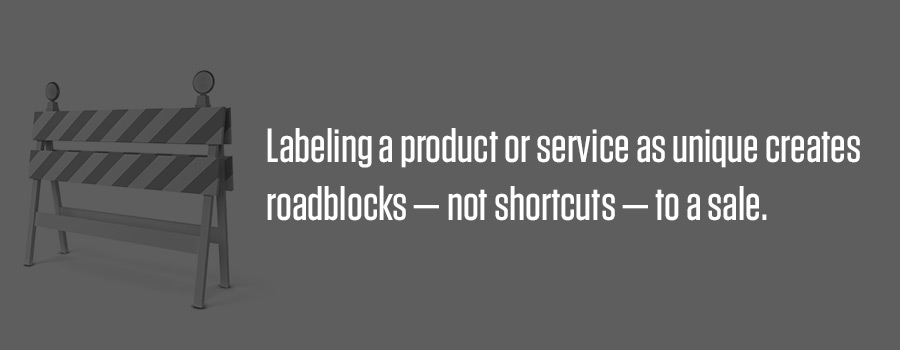
Being Unique Is A Bad Way To Sell
When you read marketing and sales copy, you see the word “unique” all the time. Everybody wants to be unique because, so the thinking goes, a unique product or service will reel in prospects like nothing else.
In reality — this is my view, not necessarily the agency’s — being unique is vastly overrated. In fact, being unique can be detrimental to generating leads.
Marketers Love Unique. Prospects Don’t.
Uniqueness is an attribute marketing people love. If you’re selling your product or service to marketers, touting a unique attribute may work. However, if you’re selling to anyone else, it probably won’t work.
Solve my problem.
If I’m a plant manager, an IT director, a purchasing agent or in some other decision-making or decision-influencing capacity, I’m interested in whether your idea saves me money, solves my problem or improves my life. I don’t care whether your idea is unique or as old as the hills; if you bring me an idea that saves me money, solves my problem or improves my life, I’ll buy it.
Touting uniqueness is inward thinking. You’re proud of your innovation, your accomplishment — as well you should be. But the people you are selling to have their own agenda, and that is what dictates their buying decisions. Offering a unique item may briefly grab their attention, but it won’t make them buy anything.

Reduce my risk.
Beyond that, being unique can be a BIG negative. Buying something unique implies risk, and as we all know, businesses are notoriously risk-averse. No matter what a buyer tells you, part of the thinking is: Do I really want to stick my neck out and buy an untested, unproven product? If it fails, I’m going to look like an idiot. I’ll lose my job and my reputation. Let some competitor take a chance; I’ll sit back and see how it turns out. I can always jump on the bandwagon later.
This line of reasoning is not unusual. When I was in the packaging business, we sold commodities and highly innovative products. The innovative products were by far the hardest to sell, and the hardest to sell profitably. Hard to sell because a new concept has to be explained in detail, tested, reviewed by committees and tested again. Hard to sell profitably because newness requires extended warranties, generous return policies and extensive guarantees. If the unique product produces so much as a hiccup in operation, there will be hell to pay.
Selling something recognizable is easier than selling something that isn’t. Labeling a product or service as unique creates roadblocks — not shortcuts — to a sale. In light of this, companies with a unique product should develop a sales pitch that positions it as something familiar — to demystify it and take the fear out of buying it.
I’ve heard it all before.
Another serious issue with positioning an item as unique is what I mentioned at the top of this article — everybody is doing it. When buyers hear claims of uniqueness, they may well think, “Yeah, right.” The problem is, “unique” has become a throwaway adjective. So, if you tout your product as unique, buyers who accept the claim are immediately concerned about risk, and ones who don’t accept it immediately think you’re shady. It’s a no-win situation!
What Are You Really Selling?
Uniqueness is a marketing shortcut that turns out to be a sales detour. Slapping the “unique” label on a product or service takes away the hard work of articulating why the thing is worth buying. It takes away the necessity of putting yourself in the customer’s shoes and seeing things from his or her point of view.
You might be thinking, "Calling my product 'unique' gets me in the door. It arouses curiosity." True enough — sometimes it does. However, if instead you say your product can improve throughput 25 percent, or reduce monthly utility bills 25 percent, or increase space utilization 25 percent, I contend that type of claim will open even more doors — because now you won’t be appealing to the merely curious (a small percentage of buyers), and instead will be appealing to the conscientious (a much bigger percentage).
In short, sell what your customers are buying: savings, solutions and improvements.
Not unique advice, but advice that has certainly stood the test of time!




